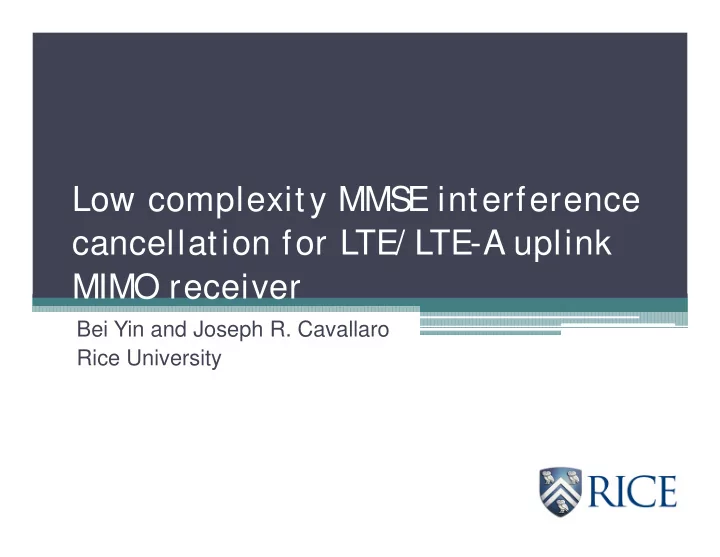

Low complexity MMS E interference cancellation for LTE/ LTE-A uplink MIMO receiver Bei Yin and Joseph R. Cavallaro Rice University
2 Motivation • Interference degrades receiver performance. • Current cancellation schemes for LTE/LTE-A are not suitable for SDR implementation. ▫ Not flexible to support different configuration. ▫ Large feedback latency -> low throughput. ▫ High complexity -> huge resource. Low complexity interference cancellation.
3 Outline • LTE/LTE-A and SC-FDMA • Interference and cancellation • Proposed partial interference cancellation • Performance comparison • Complexity analysis
4 LTE/ LTE-A uplink • LTE (release 8) ▫ Peak rate from 5 Mbps to 75 Mbps. ▫ MIMO from 1x2 to 4x4. ▫ Modulation from QPSK to 64-QAM. ▫ Bandwidth from 1.4 MHz to 20 MHz. • LTE-A ▫ Carrier aggregation. ▫ Backward compatible with LTE. ▫ Peak rate up to 500 Mbps. ▫ Bandwidth up to 100 MHz. • SC-FDMA is adopted for uplink.
5 S ingle-carrier FDMA • DFT-precoded OFDM. • Low Peak to Average Power Ratio (PAPR) to OFDM -> Low power for user equipment. Single-carrier FDMA
6 Interference • Inter-antenna interference • Inter-symbol interference � � � � � � � � �� � � � � From all symbols in the From all other antennas. same SC-FDMA symbol.
7 Residual interference after FDE � � � � � � � � � � � � � ��� � � � ������� ��� Desired Noise Residual symbols interference
8 Conventional interference cancellation � � � � � � ��� � � � � � � � � � � � � ��� � � � � � � � � ������� ������� ��� ��� Regenerated interference
9 Interference power • Necessary to cancel all the interference? Strongest interference Enough to only cancel these?
10 Proposed low complexity scheme • Two improvements ▫ Only cancel the strongest interference. Less feedback symbols needed -> Less storage. ▫ Time domain cancellation without extra DFTs. Shorter feedback latency. Lower complexity.
11 Partial interference cancellation � � �� � ��� � � � � � � � � � � � � ��� � � � � � � � � ������� ���� �� ��� ��� Regenerated partial interference
12 S imulation parameters • Different configuration of LTE/LTE-A standard ▫ Length of DFT: 512 ▫ Length of IDFT: 300 ▫ Length of CP: 36 ▫ Modulation order: 16-QAM, 64-QAM ▫ Number of antennas: 2x2, 4 x 4 • Channels: Rayleigh; Winner C1 • FDE: MMSE-FDE • TDE: MMSE-TDE • � �� : 15 • � �� : 15
13 Performance comparison 4x4 MIMO;16-QAM;Rayleigh channels 4x4 MIMO;64-QAM;Rayleigh channels • Partial IC improves the performance by a few dB from no IC. • No performance loss compared with conventional full IC.
14 Complexity analysis 12000 Number of multiplications per SC-FDMA symbol 10000 8000 6000 Full IC 4000 Partial IC 2000 0 1x1 2x2 4x4 Number of antennas • Partial IC is less than 13.7% of conventional full IC. • Reduction is from less IC and removal of extra DFTs.
15 S ummary • Performance of partial interference cancellation is almost same as full interference cancellation. • Complexity of partial interference cancellation is 86.3% lower than full interference cancellation. • Feasible for SDR receiver. ▫ Support different configuration. ▫ Shorter feedback latency. ▫ Lower complexity. ▫ Less data storage.
Recommend
More recommend